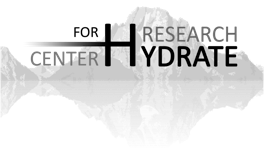



Last updated: May 18, 2015 | Contact Webmaster | © 2015 CHR-CSM
LOGIN
REQUIRED:


RESEARCH AREAS:

RESEARCH AREAS
FLOW ASSURANCE

Another important problem has
been the prediction of how long it would take for a hydrate plug to
dissociate once it had formed. A decade of research has allowed the
CSMPlug program to make an order-of-magnitude estimate of the
dissociation time under three different conditions: one-sided
depressurization, two-sided depressurization, and electrical heating
[3].
Traditionally hydrate
blockages have been prevented by the addition of large quantities of
thermodynamic inhibition chemicals such as methanol or mono-ethylene
glycol to the flowline. These chemicals lower the temperature required
for hydrate formation. Recently, the industrial paradigm has been
shifting from this time-independent approach of hydrate avoidance
towards time-dependent hydrate management.
Key to this paradigm shift
has been the development and industrial implementation of Low Dosage
Hydrate Inhibitors (LDHIs) [4], such as Kinetic Hydrate Inhibitors
(KHIs) and Anti-Agglomerants (AAs).
Time-dependent phenomena have
long been a focus of research at the Center for Hydrate Research. Since
2003, our goal has been to understand the mechanisms for hydrate
formation in oil flowlines. To this end, a hydrate kinetics model
called CSMHyK has been developed, integrated into the OLGA® multiphase
simulator, and tested against three different industrial scale
flowloops [5]. The model currently uses an empirical equation for
hydrate growth with fitting parameters regressed based on flowloop data
for crude oil systems.
The research in the Center
continues to further refine the CSMHyK model for oil and gas flowlines,
such as:
-
•Experiments in a high pressure cell fitted with FBRM and PVM probes to give new insight into the way that entrained water droplets convert to hydrate agglomerates.
-
•High pressure DSC measurements to probe the effect of hydrates on water-in-oil and oil-in-water emulsions behavior and emulsion stability.
-
•Development of growth models with a more fundamental basis to identify the most critical unknown physical parameters.
-
•High pressure rheometry to understand how hydrate particles affect the flow properties of crude oils.
-
•Experiments and simulations on particle flow to understand the jamming behavior of hydrate particles.
-
1.E. G. Hammerschmidt, “Formation of Gas Hydrates in Natural Gas Transmission Lines,” Industrial Engineering & Chemistry, 26:851 (1934).
-
2.A. L. Ballard, A Non-Ideal Hydrate Solid Solution Model for a Multi-Phase Equilibria Program, Ph.D. Thesis, Colorado School of Mines (2002).
-
3.S. R. Davies, M. S. Selim, E. D. Sloan, P. Bollavaram, D. J. Peters, “Hydrate Plug Dissociation,” AIChE Journal, 52:4016 (2006).
-
4.M. A. Kelland, “History of the Development of Low Dosage Hydrate Inhibitors,” Energy & Fuels, 20:825 (2006).
-
5.D. J. Turner, J. Boxall, S. Yang, D. M. Kleehammer, C. A. Koh, K. T. Miller, E. D. Sloan, “Development of a Hydrate Kinetic Model and its Incorporation into the OLGA2000® Transient Multiphase Flow Simulator,” Proceedings of the 5th International Conference on Gas Hydrates, Paper No. 4018, pp1231-1240, Trondheim, Norway (2005).

